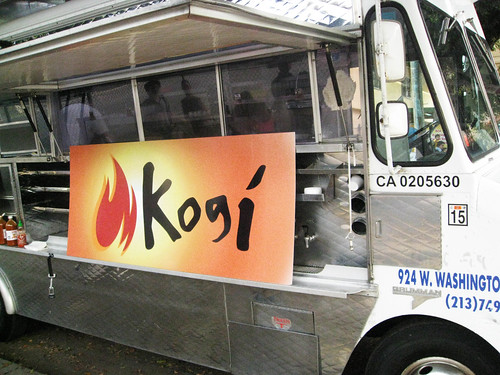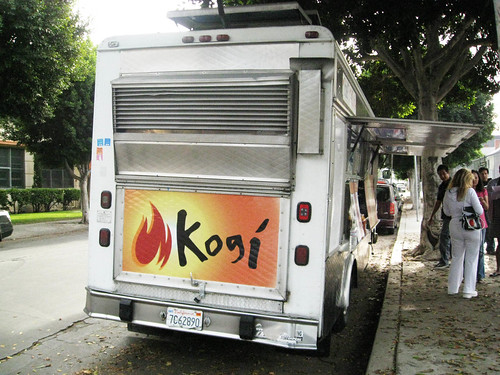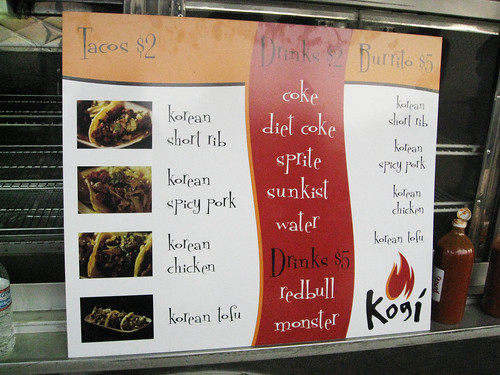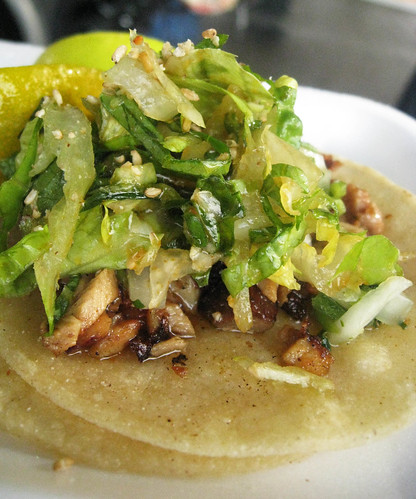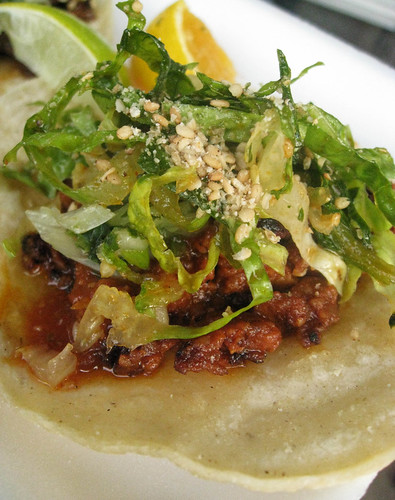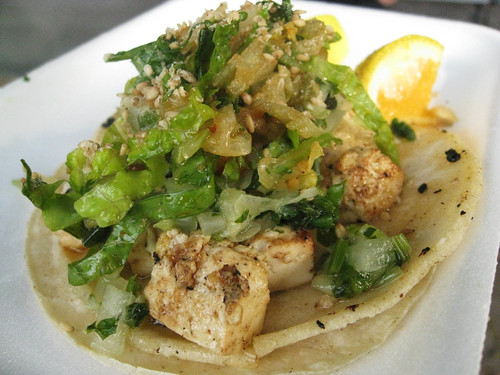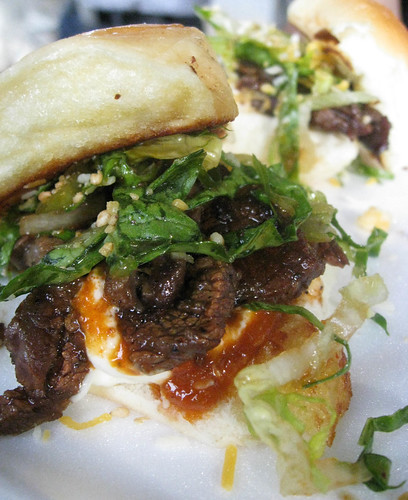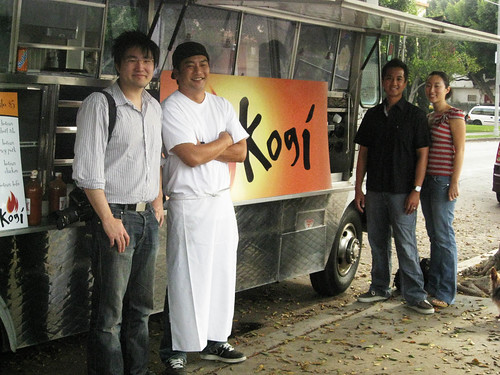
As you're reading the title of this blog entry, you may be wondering exactly what is an "xiao long bao" or XLB for short. While no expert, this is what I came up with in my initial research about this tasty dumpling treat.
To start, xiao long bao (literally "little basket bun"; also known as a soup dumpling) is a type of baozi (filled bun or bread-like item) from the Southern provinces of China, including Shanghai and Wuxi. Xiao Long Baos are traditionally steamed in bamboo baskets, hence the name.
It can be filled with hot soup and meat and/or vegetarian fillings, as well as other possibilities. The fillings are wrapped in something like a jiaozi wrapper that turns almost translucent after being steamed. Also referred to as Shanghai steamed buns or juicy dumplings, they can be recognized by their unique design, as the filled wrapper is gathered up into fine folds at the top, prior to steaming.
 One way to eat your XLB generally involves pouring Chinese black vinegar into the small saucer which contains ginger that usually arrives with your order. Gently dip the dumpling into the vinegar and than deposit onto a Chinese soup spoon. Take a bite out of the skin and sip the soup out. Then you can drizzle some vinegar on top along with the ginger and then enjoy the rest of the dumpling. Of course, there are may be other ways to eat XLBs, but in the end, just find the way that works best for you, keeping in mind that the soup coming out of the dumpling may be quite hot.
One way to eat your XLB generally involves pouring Chinese black vinegar into the small saucer which contains ginger that usually arrives with your order. Gently dip the dumpling into the vinegar and than deposit onto a Chinese soup spoon. Take a bite out of the skin and sip the soup out. Then you can drizzle some vinegar on top along with the ginger and then enjoy the rest of the dumpling. Of course, there are may be other ways to eat XLBs, but in the end, just find the way that works best for you, keeping in mind that the soup coming out of the dumpling may be quite hot.
Those of you familiar with the San Gabriel Valley know that we are blessed with some of the best and authentic Chinese dining outside of China itself. What's even more exciting is that there is quite a of variety of regional Chinese cooking styles reflected in the restaurants in the area, which is why I actually had to narrow my choices down to just 4 for the "Xiao Long Bao" crawl that I set up for my
dining group. Of the 4, I've already visited three on separate occasions, but this time I wanted to have more of a "side by side" comparison. The crawl started in a shopping plaza in the city of San Gabriel because there were literally three Shanghai restaurants right next to each other that served XLBs.

Our first stop was Mei Long Village where our group of 8 sat down and ordered an order each of their Crab and Pork XLBs and their Pork XLBs. When asked if we wanted anything else, I simply said No and believe me, we got some very puzzled looks from the wait staff during our short time there. Those puzzled looks basically followed us into the next two restaurants as well.
Soon both sets of XLBs arrive. By the way, as you're looking at my photos, you may notice that I add black vinegar to my Chinese Spoon before adding the XLB. My personal preference is to sip the

soup along with the vinegar. Anyway, back to the soup dumplings. First, I want to comment on the dumpling wrapper, which while not as thin as the ones at the famed Din Tai Fung or as thick as the ones at J&J, which we'll be visiting later on, it still retained some delicate characteristics. It was a happy medium. As for the soup inside, it had a good amount, but while the pork filling was seasoned well, the crab/pork filling actually was literally a little hard and the crab flavors were not shining through, but for the most part, the soup dumplings at Mei Long Village were a good start for our crawl.

Next up was Dragon Mark, which was right next door. At Dragon Mark, they only had the Pork XLBs on the menu, so that's what we ordered. When it came to appearance, they were smaller and tighter than the soup dumplings we had at Mei Long Village. They actually fit quite compactly on my spoon whereas the MLV dumplings didn't. We were hoping that good things came in small packages. Unfortunately, while the pork filling itself was quite tasty, everything else fell beyond the mark,

pun intended. The dumpling skin was thick, a little hard to bite into and there was hardly any soup to speak of. It was definitely time to move on.
Our next stop was J&J, right next door to Dragon Mark. Compared to MLV and Dragon Mark, this was the busiest of the three Shanghai restaurants which definitely was a good sign. At J&J, the menu had both pork and crab/pork XLBs and of course, we ordered both. One thing to note here is that the XLBs on the menu are referred to as Steamed Pao, so that's what you'd actually order. Soon the dumplings arrived and compared to Dragon Mark and even to MLV, they were quite bountiful.

While not delicate like at MLV or hard like at DM, the dumpling skin for the J&J XLBs was thick and a little chewier, but given the filling, the skin was perfect for what was needed. As for the fillings, remember how I mentioned the word "bonanza" earlier? J&J's soup dumplings were amazing. The crab/pork XLB was definitely the hit with the entire group.
Whereas with the MLV crab/pork soup dumpling, you could barely make out the crab, the J&J version was chock full of crabby flavor and along with J&J's pork XLB, both of them really brought a new definition to the words "soup dumpling." If the skin was any thinner, the soup

probably would be leaking out. J&J definitely was not shy when it came to the amount of soup in their XLBs, especially when in immediate comparison to the stinginess of the XLBs we had at Dragon Mark.
If we had ended our XLB crawl at J&J, no one would have complained. That's how happy we were about J&J, but how can you do a true XLB comparison without stopping by Din Tai Fung, the restaurant who many feel serves the best soup dumplings in town, so DTF became the last stop in our journey and for that we piled into cars and made the trip to Arcadia.

Although our primary reason to visit Din Tai Fung was their soup dumplings, both their pork and crab/pork XLBs, we decided to order a few other items as well. Since most of us have never had their regular non-soupy dumplings, we got the chicken dumplings and the shrimp/pork dumplings. Both were tasty and while not soupy, their fillings were moist and were seasoned well.
Other additions included the Shanghai rice cakes and the prettily presented rice and pork shiaomai. We also ordered red bean steamed

dumplings which was a first for me since my usual experience with red bean fillings is in something fried/deep fried. The other dishes we ordered did not disappoint.
So now on to the famed Din Tai Fung XLBs, which were an interesting mix of the other three soup dumplings we tried. The dumpling skin was delicate or actually more delicate than the MLV version so I felt like I had to take extra care picking them up with my chopsticks. They were small and compact like the Dragon Mark version. Like the J&J version, these soup dumplings were definitely soupy and overall, I can see why the Din Tai Fung XLBs always gets lots of praise. What's also fun about DTF is that you can actually see the dumpling makers at work through glass windows.

In the past, DTF has been my go to place for soup dumplings. However, after these side-by-side comparisons, my 7 other dining companions and myself came to one conclusion. Simply, of the 4 XLB versions we tried, we all liked the soup dumplings at J&J the best with the crab/pork being the top choice overall.
While we liked the DTF soup dumplings, the flavors of the fillings seemed almost too subtle. What J&J had over DTF was a bolder flavor. Simply, you took a bite out of the J&J crab and pork soup dumpling and you could really taste the crab and their pork XLBs really tasted "porky." Our group also felt that the J&J XLBs had more soup and that the soup was more flavorful overall. In general, the conclusion of this whole XLB crawl was a bit unexpected. I really thought that Din Tai Fung would win the day, but for this group of diners, DTF was second place followed by Mei Long Village, with Dragon Mark being a distant last.
Overall, it was a really fun foodie experience and the fact that I was able to do something that involved visiting 4 different Shanghai restaurants just to eat one specific type of regional ethnic food is one of the main reasons I love dining in Los Angeles. I'm pretty sure that restaurants serving xiao long baos in close proximity to each other is not something you'll find in just any town across the US, so I definitely consider myself very lucky. One last thing to mention is that between the 8 of us, this crawl cost us around $16 each, with the bulk of the money spent at Din Tai Fung since we had ordered other dishes. So if you want to do a little XLB exploring on your own, pull a few friends together and maybe your outcome would differ from ours.
To see pics, go to:
http://www.flickr.com/photos/la_addict/sets/72157610565855764/Mei Long Village
301 W Valley Blvd
San Gabriel, CA 91778
(626) 308-9238
Dragon Mark
301 W Valley Blvd # 110
San Gabriel, CA 91776
(626) 282-5953
J&J
301 W Valley Blvd
San Gabriel, CA 91804
(626) 308-9238
Din Tai Fung
1108 S. Baldwin Avenue
Arcadia , CA 91007
626-574-7068

















































